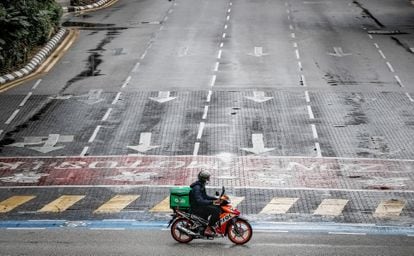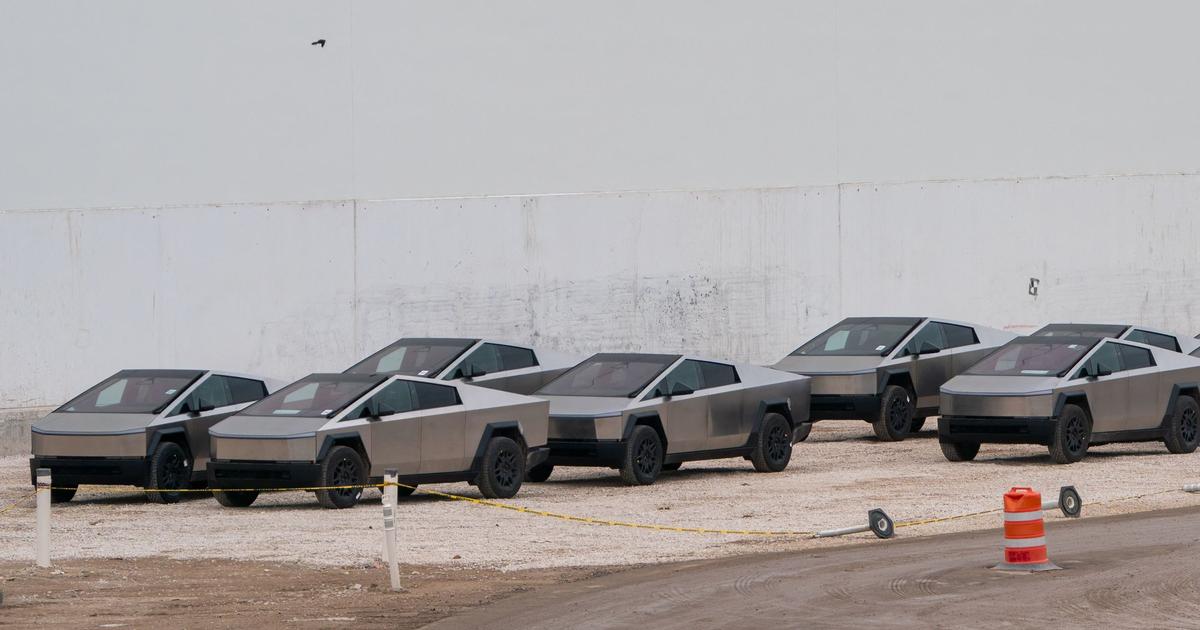Talking about the work of the future is opening the door to dreams and nightmares: from the image of the independent professional with a mobile, laptop and views of the beach;
even that of the delivery man unable to comply with his algorithms, without unemployment, sick leave or retirement.
How that future ultimately takes will depend on country, background, and gender, to name just three of the many variables that make an exact prediction impossible.
But where the prophecy ends begins the analysis of the forces that are already shaping the new ways of working today.
That is the objective of this report.
More information
The future of work
Telecommuting is not just for office workers
They call it Twin Model (twin model, in English) and one of the sectors that uses it the most is hydrocarbons.
In this industry it is usually a digital replica of the oil plant that allows remote control.
Thanks to the sensors installed on the ground, its twin on the computer screen informs the user in real time, wherever they are, about maintenance levels, the capacity of the tanks, or any other data necessary for an operation that, in part, you can also run remotely.
According to Prithwiraj Choudhury, professor of Business Administration at Harvard Business School, advances such as the Twin Model are what will take teleworking to its next frontier: the industry and many services that until now have required the physical presence of its participants, " like the operating room of a hospital ”. Choudhury believes that the possibility of telecommuting popularized during the pandemic will mean a leap forward for employees and employers of the near future.
For the former, because it will allow them to move to more pleasant areas, closer to their loved ones, or cheaper, "which increases the purchasing power of their salaries." Another advantage that in his opinion will especially benefit women is the possibility of facing a family move without either spouse having to give up their job. “In the last 30 years, women have lost many opportunities when they were offered jobs or promotions that required them to move and their partner refused to change cities,” she explains.
Choudhury has been researching telework for seven years and is among those responsible for an experiment in the United States patent registry, where they began by giving permission to some employees to work from home and ended up authorizing them to do so from anywhere in the world . The study showed notable improvements in productivity and in the level of employee retention, in addition to the obvious advantages of savings in office rent.
But will we be just as creative without the coffee talks? And how will we do when we want to be seen and taken into account for possible promotions? According to Choudhury, working from outside the office doesn't have to be a hindrance for that. “Research that MIT has been doing on the subject since 1977 shows that these informal office interactions only happen in a very limited radius of 25 meters, with the probability falling drastically when there is a wall between the two employees, and becoming practically impossible. when they work in two different buildings on the same campus, ”he says.
In his studies, the work of the future will be able to compensate for the lack of interaction in situ with what he calls “virtual water dispensers”, in reference to that moment of rest to drink water.
Unlike the
Zoom
happy hour
that some companies organize as a relaxation mechanism, these virtual water dispensers would involve groups of randomly selected employees, but guaranteeing a good mix of hierarchical ranks.
"In an experiment we did with a study group and a control group, we found that fellows who participated in dispensers with senior management performed better in the following weeks and increased their likelihood of being offered a position."
More information
The 'hot office' arrives
But the office is also one of our main places of socialization, something that according to Choudhury will not be lost as long as we have regular meetings in the office, with 80% remote work and 20% face-to-face, or the percentages that each company chooses.
"The offices will be used as a place for social interaction and that means we will have to reimagine the space, throw out cubicles and walls, and create social places, a community kitchen, a music room, meeting rooms, collaboration rooms, etc." .
Offices, like this one in London, adopt new configurations to accommodate a smaller capacity.Jason Alden / Bloomberg
A future that seems utopian except for the possible risks for employees. Many companies will prefer to avoid rigidities and Social Security contributions by turning their workforce into external providers, when not to eliminate it completely by hiring the services of people in countries with lower labor costs. Not to mention the pressure for overtime and unpaid hours, as has already been demonstrated during this health crisis. For the first part, there is no other solution than to improve the rights and protection of workers. And to avoid excesses in the hourly load, says Choudhury, it will be necessary to go from measuring performance by time spent to measuring it by production obtained. "In some tasks it is more difficult to measure productivity, but there is always some variable to do it, such as the response of customers."
The century of centenarians
According to a study by the World Economic Forum, if children born in 1947 had a life expectancy of 85 years, for those born in 2007 the expectation will be to celebrate the first centenary, something that will necessarily have consequences in the world of work.
As consultant Diana Wu David wrote in her book
Future Proof: Reinventing Work
, "having longer lives will mean a greater need for capital accumulation."
The growing participation of the elderly in the labor market is already a fact.
According to Wu David, in the United States less than 13% of those over 65 were employed in 2000, a percentage that jumped to almost 19% in 2016.
In Spain, a June Manpower study confirms this trend: employees with more than 45 and less than 66 went from representing 39% of the workforce in 2010 to becoming 47% just nine years later.
Against this background, Wu David believes that the delay in the retirement date will be as inevitable as it is positive.
By having longer working lives, he says, there will not be as much pressure to progress quickly, we will alternate work periods with learning periods, and technology will allow us to create networks of collaborators for those who want to continue working even after retirement.
But who will pay for those learning periods?
And who will ensure the income of so many centenarians?
According to Wu David, who lives in Hong Kong, the world could go to the Singapore model with its Lifelong Learning and Lifelong Income Scheme programs.
The first subsidizes education throughout the life of its citizens.
The second makes the collection of the pension more flexible, voluntarily postponing the date on which it begins to be collected and, in the event of death earlier than expected, guaranteeing the return to the relatives of the undelivered part.
On the move towards gender equality
The machines are not going to take all the jobs. As Erik Brynjolfsson and Andrew McAfee have been writing since their book The Second Machine Age, in creative tasks such as art and science, in tasks that put emotional intelligence into play, and in tasks that require a certain delicacy to manipulate objects, we are going to continue to have an advantage over them. A good opportunity for the employment of women, says the IMF economist Era Dabla-Norris, as they are the most represented in human interaction jobs such as those in the health sector, care for children and the elderly, and commercial ones.
According to Dabla-Norris, who in 2019 together with Mariya Brussevich and Salma Khalid published a study on the effect of technology on gender equality in the workplace, it is not the only possible advance. In his opinion, "the probability that women occupy managerial positions is higher today than in the past." There are still many differences, she says, but there is also an increasing influx of women into science, technology and math careers.
But that is not enough to break a glass ceiling that in many cases still looks like steel.
According to Dabla-Norris, to end it, it will be necessary to follow the path opened by the northern European countries, where more progress has been made in legislating against the so-called maternity fine.
Equating paternity leave for the father and mother and making childcare available to all budgets is a proven solution that could be extended to other countries with a welfare state in the future.
Another measure that, in his opinion, could be extended to other places is to eliminate the disincentive that occurs in joint tax returns when the tax rate of the second contributor (usually the woman) is so high that it undermines the desire to work.
Race against the machine
In the reports on the technological possibilities of the future commissioned by banks and consultants, the subject is not usually touched, but the truth is that many people will not reach this idyllic setting without first going through the purgatory of unemployment. And it's not just truck drivers who are threatened by autonomous vehicles. Lawyers specialized in looking for jurisprudence or credit risk evaluators, to name just two, also face that gigantic competitor called artificial intelligence.
According to Brynjolfsson, the workforce must get out of the tasks that machines do better than we do as soon as possible to move towards the creative and emotional intelligence areas. A responsibility that, in his opinion, corresponds to citizens, who must begin to train in these new skills; to companies, which must anticipate with investments in the sectors of the future, and to governments, which must review their tax structure. "In most countries the replacement of employees by machines is being favored because the taxes that companies pay for capital are lower than those they pay for workers," he says.
Brynjolfsson is not the first to realize this gap or to understand how difficult it is to raise capital taxes in a globalized world where many companies choose their location based on taxes.
Therefore, to reduce the burdens associated with hiring employees, it proposes to increase other taxes.
"They could be taxes on pollution, the emission of carbon dioxide, congestion, or even indirect taxes on added value, which increase collection without directly penalizing capital or labor."
A food delivery boy in Kuala Lumpur, Malaysia.Wong Fok Loy / SOPA Images / LightRocket via Gett
In any case, says Brynjolfsson, our main duty is to keep in mind that it will be up to us to decide how much space technology will occupy at work. In his own words, it is up to us to decide "if we use it to create more shared prosperity or if we use it to increase the concentration of wealth."
The same, he explains, with those technologies that measure and control employee performance.
"It is in our power to decide what level of surveillance we are willing to tolerate," he explains.
“I am not an optimist who says that everything will go well;
In fact, I think that we should care a lot, and that we should make the right decisions to arrive at a scenario that could be really good, but of course we have to worry, will we be able to use technology to increase prosperity and freedom?
Or not?
It is not something at all automatic ”.
Expanding the concept of work
The last questions about the future of work are perhaps the most difficult to answer.
Will employees be protected from possible layoffs or illness?
Are we going to a world of temporary contracts?
Or will we all become outside vendors with no employment relationship?
British economist Guy Standing has been talking for years about the rise of the precariat, a class that in its definition does not include the previous generation of wage earners still entitled to things like retirement or maternity pay.
"The precariat not only suffers from the inconvenience of unstable and temporary labor relations, but their wages are falling in real terms, in addition to the loss of rights, such as paid vacations, medical leave or pension," he says.
This precariat is made up of young people who chain one temporary contract after another, and delivery men, drivers, replenishers and a long list of people who obey an algorithm under the fiction that it is an equal treatment between entrepreneurs.
In Standing's opinion, the solution for the future is to incorporate into the word work activities that until now have been left out, “like all the things that have to be done at home or like the care that needs to be given to children and parents seniors".
That recognition is not enough, of course.
Key to Standing's future is the introduction of a universal basic income that gives people the freedom to engage in these unpaid jobs and raises the bar on the working conditions that companies must guarantee in order to get employees.
Although the idea of a universal basic income is not new, Standing says his organization BIEN (Global Basic Income Network) has received more inquiries this pandemic than ever, with thousands of people joining. the Asociation. "There are currently 80 universal basic income experiments running around the world," he says.
Among the findings of experiments in high-, middle- and low-income countries, Standing highlights one they did with 6,000 people from India.
According to their data, health, schooling, nutrition and the situation of women improved.
"Inequality was reduced, there was more work, not less, and the same happened with what we did in Africa and Canada," he says.
“If we want to be able to adapt to pandemics, if we want to be able to adapt to economic shocks, we need people to have security, otherwise that work of the future will not come where we all do more creative things, in the one in which we spend more time taking care of the people we love and in which we face the ecological work that we have to face ”.
Towards the four-day journey
The five-day, 40-hour workweek seems to take us a lifetime, but it's a recent invention. The Communist Party of China granted it in 1995 and in Spain many public employees continued to work Saturday morning until the 1980s. In Iceland they completed two experiments between 2015 and 2019 in which the working day was reduced to around 2,500 workers (1.3% of the workforce) to a range of 35-36 hours per week without pay cuts. According to the Icelandic Association for Sustainability and Democracy (Alda), which analyzed the results in collaboration with the British think tank Autonomy, productivity improved in some cases and did not fall in almost any; workers said they were in better health and lower levels of stress were reported.
Some of the workers in the experiment were given the option of concentrating those 35/36 hours in four days, generating headlines around the world for the possibility of a four-day week. Some jobs cannot be reduced to shorter shifts and in other occupations a four-day week may require the hiring of more staff, but the reduction of the working day is already on the agenda of political groups around the world. As Guðmundur Haraldsson, a member of Alda and one of the authors of the report, told Wired magazine, what is clear is that “without a doubt we were wasting hours”. How to solve it? According to Haraldsson, there is something we can all do: reduce the length of business meetings.














